Enzymes are biological catalysts that increase the rate of chemical reactions taking place within living cells without themselves undergoing any overall change. Enzymes play vital roles in biological systems by acting as catalysts. A catalyst is necessary in such systems because, at the temperature and pH of the human and animal body, reactions would not occur at a rate sufficient to support rapid muscular activity, nerve impulse generation and all the other processes required to support life.
The investigation and interpretation of changes in serum enzymes in diseases is one of the most rapidly expanding fields in clinical bio-chemistry. Enzymes are unchanged by their action on their substrates; they remain as they are and active until denatured by heat or other factors or until the substrate is exhausted. Depending on the process, enzymes may be removed from the final product, or denatured and left in, or may even be potentially active. How they are labelled in final product formulations should be dependent on the specific outcome for the product in question.
Enzymes have wide or extensive applications in different fields of research or areas of life. In human and veterinary medicine, the assay of plasma enzymes can be very useful in helping to confirm the diagnosis of diseases in humans and animals. In recombinant DNA technology (sometimes called genetic engineering), varieties of enzymes are used, e.g. restriction endonucleases (from bacteria) and DNA ligases (from bacteria or bacteriophages), to insert extra genes into cells with the help of vehicles termed vectors. The diagnosis of an inborn error of metabolism can be established by demonstrating the reduced activity of a particular enzyme in at issue, or by revealing a gene abnormality by recombinant DNA technology.
Enzymes are also applied in the management and treatment of some diseases. Enzymes are used as reagents in clinical biochemistry and in the industry. Enzyme assay is very important in the food and drink industries in monitoring the processing and storage of foods and drinks and as a means of detecting microbial contamination. All these applications will be discussed in details.
Due to the importance of enzymes and its wide applications in biochemistry, biotechnology, chemistry, genetics, industries, human and veterinary medicine etc., this review is an attempt to gather together the different uses and applications of enzymes for the purposes of teaching and research.
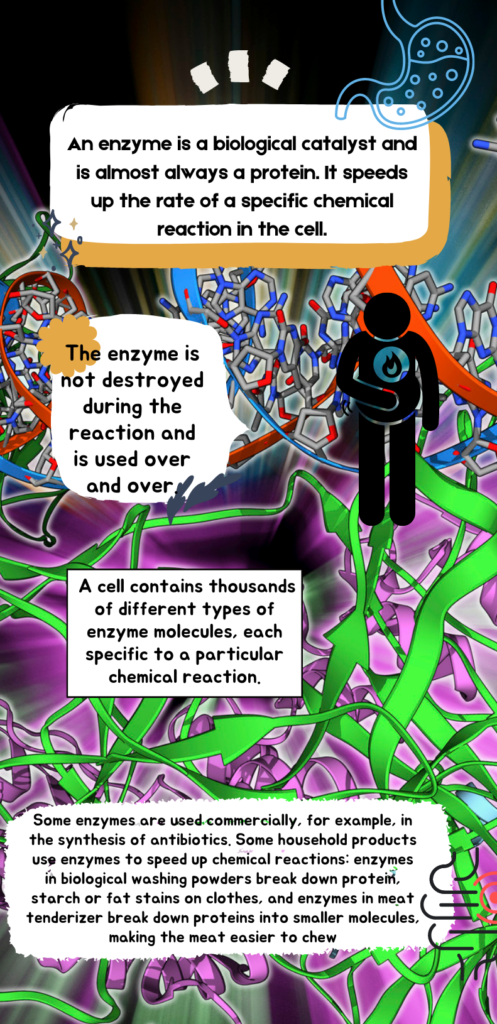
BIOMEDICAL IMPORTANCE OF ENZYMES
Enzymes are biologic polymers that catalyze the multiple dynamic processes which makes life processes possible. Enzymes play central role in health and disease because they are determinants of the rates at which physiologic events take place.
The breakdown of foods to supply energy and chemical building blocks, the assembly of these building blocks into proteins, membranes and the DNA that encodes genetic information and the harness-sing of energy to produce cell movement are all made possible by the carefully coordinated actions of enzymes.
While in health, all biochemical and physiological processes occur in an ordered, regulated manner and homeostasis is maintained, homeostasis can be profoundly disturbed in pathologic states. For example, the severe tissue injury that catalyses liver cirrhosis can profoundly impair the ability of cells to form the enzymes which catalyze a key metabolic process such as urea synthesis. The resultant inability to convert toxic ammonia to nontoxic urea is then followed by ammonia intoxication and ultimately hepatic coma.
A series of rare but frequently debilitating and often fatal genetic diseases are additional examples of the drastic physiologic consequences that can follow impairment of the activity of a single enzyme. Following severe tissue injury (e.g. cardiac or lung infarct, crushed limb, liver damage or trauma to the liver) or uncontrolled cell growth (e.g. prostatic carcinoma),enzymes that may be unique to specific tissues are released into the blood.
Measurement of these intra-cellular enzymes in blood serum therefore provides medical and veterinary doctors with invaluable information on the diagnosis and prognosis of diseases in the human and animal body/system.
Enzyme Commission (E.C.)
This is a special commission of the International Union of Biochemistry (IUB) that made recommendations for the classification and naming of enzymes and for the definitions of the mathematical constants used in enzymology.
Enzyme classification
This is the systematic arrangement and the naming of enzymes that is based on the 1972 recommendations of the Enzyme Commission of the International Union of Biochemistry. Reactions and the enzymes that catalyze them form 6 classes, each having4-13 sub classes. The enzyme name has 2 parts. The first names the substrate or substrates. The second, endogenize, indicates the type of reaction catalyzed.
Each enzyme is denoted by a number composed of four figures. The first figure denotes one of the six main divisions: oxidoreductases, transferases, hydrolases, lyases, isomerases and ligases. The second figure denotes the subclass and the third figure denotes the sub-subclass. The last figure denotes the serial number of the enzyme in its sub-subclass.
The enzyme number is preceded by the abbreviation E.C. For example, E.C.2.7.1.1 denotes class 2 (a transferase), subclass 7 (transfer of phosphate), sub-subclass 1 (an alcohol is the phosphate acceptor). The final digit denotes hexokinase, or ATP: D-hexose 6 -phosphotransferase, an enzyme catalyzing phosphate transfer from ATP to the hydroxyl group on carbon 6 of glucose. There are 6 classes of enzymes. They are:
- Oxidoreductases: These enzymes are involved in oxidations and reductions of their substrates e.g. alcohol dehydrogenase, lactate dehydrogenase, xanthine oxidase, glutathione reductase, glucose-6-phosphate dehydrogenase.
- Transferases: These enzymes catalyze the transfer of a particular group from one substrate to another e.g. a aspartate amino transferase (AST), alanine amino transferase (ALT), hexokinase, phosphoglucomutase, hexose-1-phosphate uridylic transferase, ornithine carbamoyl transferase etc.
- Hydrolases: These enzymes bring about hydrolysis. g. glucose- 6 -phosphatase, pepsin, trypsin, esterase’s, glycoside hydrolases etc.
- Lyases: These are enzymes that facilitate the removal of small molecule from a large substrate e.g. fumarase, agrion succinate, histidine decarboxylase.
- Isomerases: These enzymes are involved in isomerization of substrate e.g. UDP-glucose, epimerase, rationalism erase, racemases, triose phosphate isomerase.
- Ligases: These enzymes are involved in joining together 2 substrates e.g. alanyl-t-RNA synthetase, gluta-mine synthetase, DNA ligases.
Enzyme specificity
Specificity is an important characteristic of enzymes. The3 different types of enzyme are specificity/specificities are:
- Stereochemical specificity.
- Reaction specificity.
- Substrate specificity, which can be absolute or relative substrate specificity.
Enzyme kinetics
This is the kinetics of enzyme-catalyzed reactions. It includes derivations of rate equations and graphical analysis of experimental data for all types of enzyme reactions such as single or multiple substrate reactions, uninhibited or inhibited reactions, equilibrium or steady-state systems.
Immobilized enzyme
This is an enzyme that is physically confined while it carries out its catalytic function. This may occur naturally, as in the case of particulate enzymes, or it may be produced artificially by chemical or by physical methods. In the chemical methods, the enzyme is linked covalently to a support.
These methods include attachment of the enzyme to a water-insoluble support, incorporation of the enzyme into a growing polymer chain, or cross linking of the enzyme with a multi-functional low molecular weight reagent. In the physical methods, the enzyme is not linked covalently to a support. These methods include adsorption of the enzyme to a water-insoluble matrix, entrapment of the enzyme are within either a water-insoluble gel or a micro-capsule, or containment of the enzyme are within special devices equipped with semipermeable membrane. Enzyme immobilization technique has two advantages:
- Expensive enzymes can be recovered and used again.
- The enzyme can also be used in a variety of configurations of bioreactors that permit continuous operation.
COMMERCIAL APPLICATIONS OF IMMOBILIZEDENZYMES
Immobilized enzymes are mainly used in the production of high fructose syrups (also known as HFCS or iso-glucose). Other commercial uses include production of semi-synthetic penicillin’s, the hydrolysis of starch using amyl glucosidase and the resolution of DL-mixtures of amino acids. Immobilized enzymes also have applications in the medical sciences.
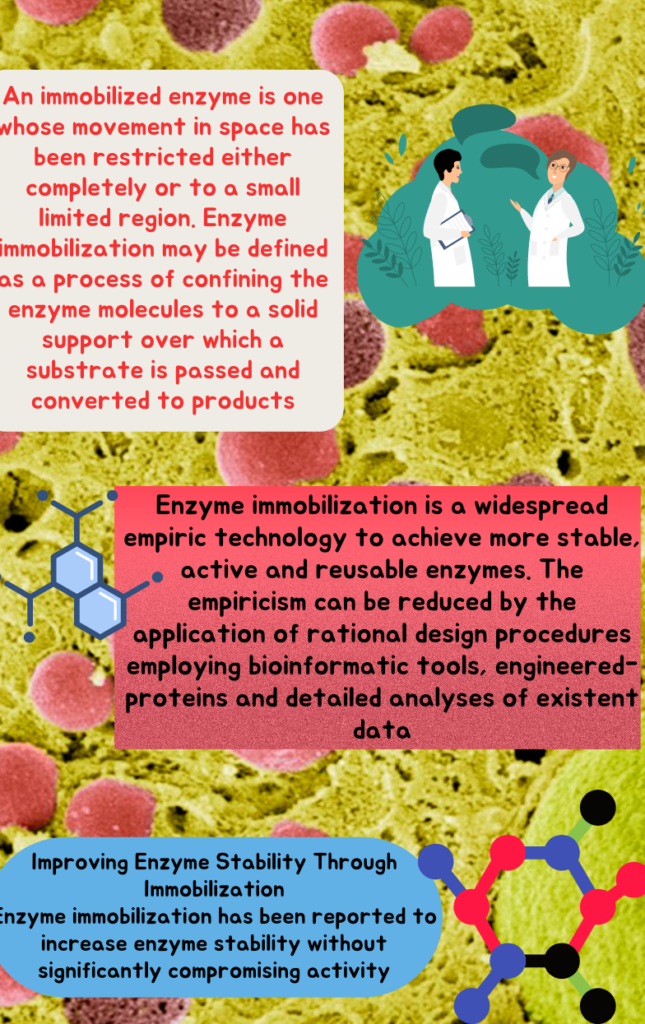
Enzymes and coenzymes
Many enzymes require a coenzyme which functions as group transfer reagents. Many enzymes that catalyze group transfer and other reactions require, in addition to their substrate, a second organic molecule known as a coenzyme, without which they are inactive.
Coenzymes expand the repertoire of the catalytic capabilities of an enzyme far beyond those offered by the functional groups alone of the amino acids that constitute the bulk of the enzyme. Coenzymes that are tightly associated with an enzyme through either covalent bonding or non-covalent forces are often referred to as prosthetic groups.
Coenzymes that are freely diffusible generally serve as continually recycled carriers of hydrogen, flavin adenine nucleotide (reduced) (FADH), hydride nicotinamide adenine dinucleotide (reduced) (NADH) and nicotinamide adenine dinucleotide phosphate (reduced) (NADPH), or chemical units such as acyl groups (coenzyme A) or methyl groups (folates), shuttling them between their points of generation and consumption. These latter coenzymes can thus be considered as second substrates.
Enzymes that require coenzymes include those which catalyze oxidoreductions, group transfer and isomerization reactions and reactions that form covalent bonds. Lytic reactions, including the hydrolytic reactions catalyzed by the digestive enzymes, do not require coenzymes.
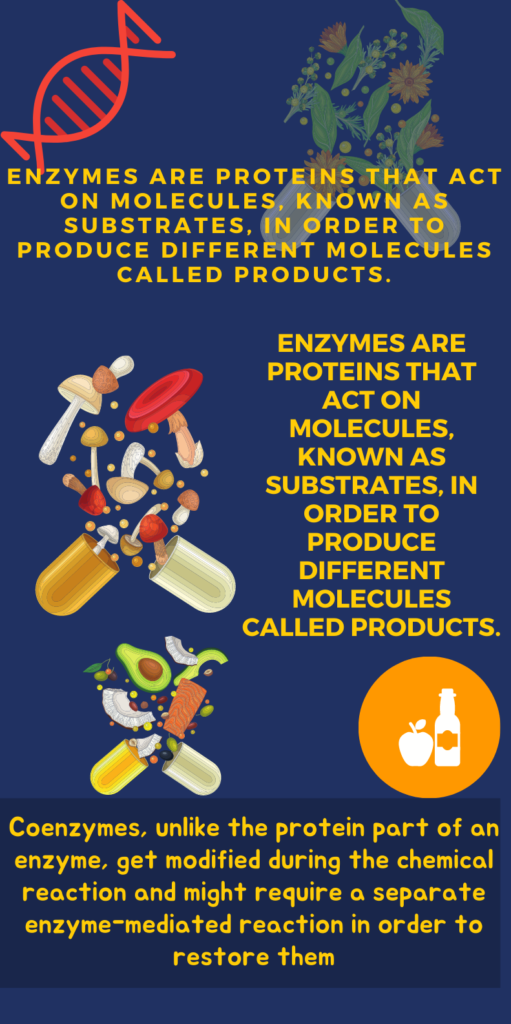
Classification of coenzymes
Coenzymes can be classified according to the group whose transfer they facilitate. Based on the above concept, coenzymes may be classified as follows:
- Coenzymes involved in transfer of groups other than hydrogen: Biotin, CoA-SH, carbamide, co-enzymes, folate coenzymes, pyridoxal phosphate, lipoic acid, sugar phosphates, thiamine pyrophosphate.
- Coenzymes involved in transfer of hydrogen. Nicotinamide adenine dinucleotide (oxidized), Nicotinamide adenine dinucleotide phosphate (oxidized). Flavin mononucleotide (FMN), Flavin adenine dinucleotide (FAD), lipoic acid, coenzyme Q.
METHODOLOGY OF ENZYME PRODUCTION
Enzymes are produced by cellular anabolism, the naturally occurring biological process of making more complex molecules from simpler ones. Source organisms include bacteria, fungi, higher plants and animals.
Enzymes may be extracted from a given source organism by a number of different methods. Most of the organisms that produce commercial enzymes are fungi.
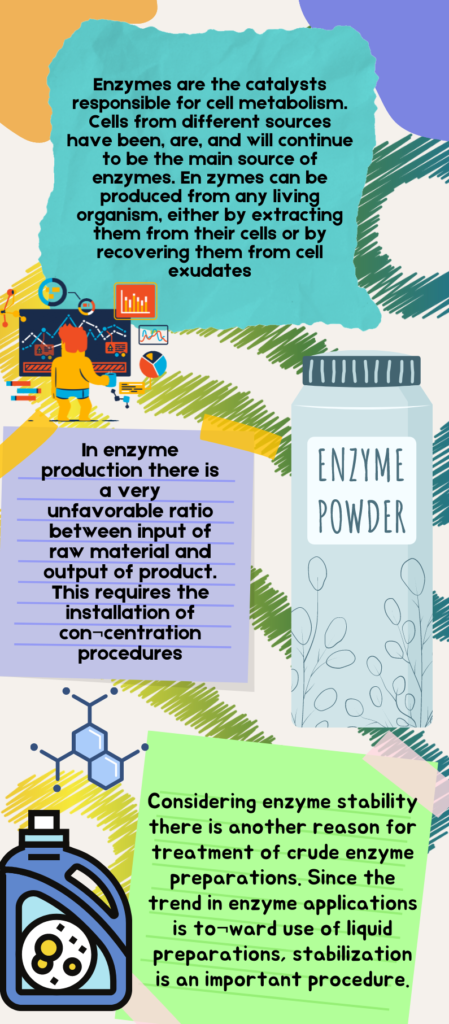
APPLICATIONS OF ENZYMES
Enzymes have a wide variety of uses. Enzymes are used in the industries (food and drinks, pharmaceutical etc ), they are used for research purposes, medical applications, commercial applications etc.
Enzymes with biochemical applications
Many enzymes are used in biochemical systems. Some of these are:
- a) aa-tRNA synthetase: It is used for charging a specific RNA molecule with the appropriate amino acid.
- b) Adenylate cyclase: It produces cyclic Adenosine monophosphate (cAMP)
.c) Aspartokinase: This enzyme catalysis the initial step in the pathway for the biosynthesis of several amino acids. It’s a key regulatory step.
- d) ß-galactosidase: This enzyme splits lactose to the constituent monosaccharides glucose and galactose. It is the first step in lactose fermentation.
- e) ß-lactamase: This enzyme hydrolyses the ß-lactam bond in the nucleus of penicillin’s and cephalosporins. It is responsible for penicillin resistance.
- f) Chloramphenicol acetyltransferase (CAT): This enzyme causes chloramphenicol resistance, by inactivating the antibiotic and is used as a selective marker and as a reporter gene.
- g) Glutamate dehydrogenase: It is important in ammonia assimilation.
- h) Luciferase: This enzyme catalysis a light-emitting reaction. It is used as a reporter.
- i) Resolvase: It catalysis site-specific recombination to resolve the co-integrate intermediate in transposition into two separate molecules.
Enzymes as markers for disease
Some enzymes are found only in specific tissues or in a limited number of such tissues. For example, lactasede hydrogenase (LDH) has 2 different forms, called isozymes, in heart and skeletal muscle. The 2 forms differ slightly in amino acid composition and can be separated on the basis of charge as a result. Since LDH is a tetramer of four subunits, it too can exist in 5 different forms depending on the source of the subunits. An increase of any form of LDH in the blood indicates some kind of tissue damage.
A heart attack can usually be diagnosed with certainty if there is an increase of LDH from heart. Also, there are different forms of creatine kinase (CK), an enzyme that occurs in the brain, heart and skeletal muscle. Appearance of the brain type can indicate a stroke or a brain tumour, whereas the heart type indicates a heart attack.
After a heart attack, CK shows up more rapidly in the blood than LDH. Monitoring the presence of both enzymes extends the possibility of diagnosis, which is useful, since a very mild heart attack might be difficult to diagnose. An elevated level of the isozyme from heart in blood is a definite indication of damage to the heart tissue. Another useful enzyme assayed is acetylcholinesterase (AChE), which is important in controlling certain nerve impulses.
Many pesticides affect this enzyme, so farm workers are often tested to be sure that they have not received inappropriate exposure to these important agricultural toxins. There are several enzymes that are typically used in the clinical laboratory to diagnose diseases. There are highly specific markers for enzymes active in the pancrease, red bloodcells, liver, heart, brain, prostate gland and many of the endocrine glands.
Since these enzymes are relatively easy to assay using automated techniques, they are part of the standard blood test veterinary and medical doctors are likely to need in the diagnosis and treatment/management of diseases.
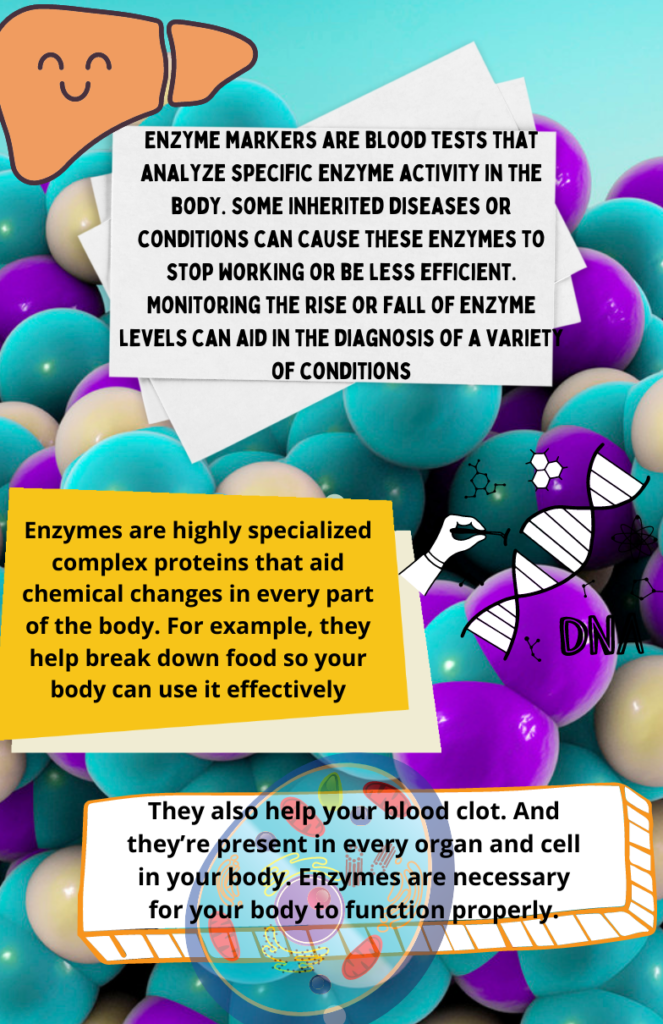
Enzymes utilized in clinical diagnoses of diseases
Many enzymes are involved in the clinical diagnoses of various diseases in human and veterinary medicine. These enzymes facilitate or enhance rapid diagnoses of these diseases. These enzymes are classified into many classes. They are:
1) Alkaline Phosphatase: Alkaline phosphatases were the earliest serum enzymes to be recognized to have clinical significance, when in the1920s, it was discovered that they increase in bone and liver diseases. Since then, they have been the subject of more publications than any other enzyme
2) Creatine Kinase: Creatine kinase isozymes are the most organ-specific serum enzymes in clinical use. They catalyse the reversible phosphorylation of creatine by ATP to form creatine phosphate, the major storage form of high-energy phosphate required by muscle. Creatine kinases are found in many parts of the body like the heart, brain, skeletal muscle and smooth muscle, but they have their highest specific activity in the skeletal muscle.
3) Alanine Aminotransferase: It was formerly known as glutamic puruvate transaminase. It catalysis the reversible transamination of L-alanine and 2-oxoglutarate to pyruvate and glutamate in the cytoplasm of the cell. ALT can be found in the liver, skeletal muscle and heart.
4) Aspartate Aminotransferase : It was formerly called glutamic oxaloacetic transaminase; GOT).It catalyses the transamination of L-aspartate and 2-oxo-glutarate to oxaloacetate and glutamate. AST is found in skeletal muscle, heart, liver, kidney and erythrocytes and is associated with myocardial, hepatic parenchymal and muscle diseases in humans and animals.
5) Sorbitol Dehydrogenase :It is also called L-iditol dehydrogenase; IDH. It catalysis the reversible oxidation of D-sorbitol to D-fructose with the cofactor NAD.
6) Lactate Dehydrogenases: It catalysis the reversible oxidation of pyruvate to L(+)lactate with the cofactor NAD. The equilibrium favors lactate formation, but the preferred assay method is in the direction of pyruvate because pyruvate has an inhibitory effect on LDH. Lactate dehydrogenase hasiso enzymes. LDH can be found in the heart, liver, erythrocyte, skeletal muscle, platelets and lymph nodes.
